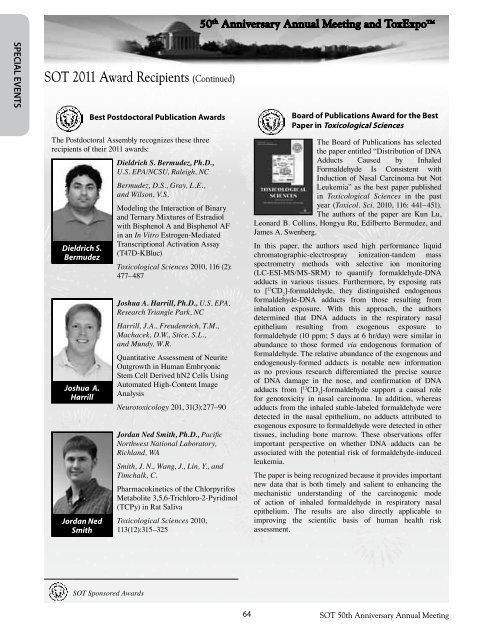Program - Society of Toxicology
Program - Society of Toxicology
Program - Society of Toxicology
You also want an ePaper? Increase the reach of your titles
YUMPU automatically turns print PDFs into web optimized ePapers that Google loves.
50 th Anniversary Annual Meeting and ToxExpo<br />
SPECIal Events<br />
SOT 2011 Award Recipients (Continued)<br />
Best Postdoctoral Publication Awards<br />
The Postdoctoral Assembly recognizes these three<br />
recipients <strong>of</strong> their 2011 awards:<br />
Dieldrich S.<br />
Bermudez<br />
Joshua A.<br />
Harrill<br />
Jordan Ned<br />
Smith<br />
Dieldrich S. Bermudez, Ph.D.,<br />
U.S. EPA/NCSU, Raleigh, NC<br />
Bermudez, D.S., Gray, L.E.,<br />
and Wilson, V.S.<br />
Modeling the Interaction <strong>of</strong> Binary<br />
and Ternary Mixtures <strong>of</strong> Estradiol<br />
with Bisphenol A and Bisphenol AF<br />
in an In Vitro Estrogen-Mediated<br />
Transcriptional Activation Assay<br />
(T47D-KBluc)<br />
Toxicological Sciences 2010, 116 (2):<br />
477–487<br />
Joshua A. Harrill, Ph.D., U.S. EPA,<br />
Research Triangle Park, NC<br />
Harrill, J.A., Freudenrich, T.M.,<br />
Machacek, D.W., Stice, S.L.,<br />
and Mundy, W.R.<br />
Quantitative Assessment <strong>of</strong> Neurite<br />
Outgrowth in Human Embryonic<br />
Stem Cell Derived hN2 Cells Using<br />
Automated High-Content Image<br />
Analysis<br />
Neurotoxicology 201, 31(3):277–90<br />
Jordan Ned Smith, Ph.D., Pacific<br />
Northwest National Laboratory,<br />
Richland, WA<br />
Smith, J. N., Wang, J., Lin, Y., and<br />
Timchalk, C.<br />
Pharmacokinetics <strong>of</strong> the Chlorpyrifos<br />
Metabolite 3,5,6-Trichloro-2-Pyridinol<br />
(TCPy) in Rat Saliva<br />
Toxicological Sciences 2010,<br />
113(12):315–325<br />
Board <strong>of</strong> Publications Award for the Best<br />
Paper in Toxicological Sciences<br />
The Board <strong>of</strong> Publications has selected<br />
the paper entitled “Distribution <strong>of</strong> DNA<br />
Adducts Caused by Inhaled<br />
Formaldehyde Is Consistent with<br />
Induction <strong>of</strong> Nasal Carcinoma but Not<br />
Leukemia” as the best paper published<br />
in Toxicological Sciences in the past<br />
year (Toxicol. Sci. 2010, 116: 441–451).<br />
The authors <strong>of</strong> the paper are Kun Lu,<br />
Leonard B. Collins, Hongyu Ru, Edilberto Bermudez, and<br />
James A. Swenberg.<br />
In this paper, the authors used high performance liquid<br />
chromatographic-electrospray ionization-tandem mass<br />
spectrometry methods with selective ion monitoring<br />
(LC-ESI-MS/MS-SRM) to quantify formaldehyde-DNA<br />
adducts in various tissues. Furthermore, by exposing rats<br />
to [ 13 CD 2<br />
]-formaldehyde, they distinguished endogenous<br />
formaldehyde-DNA adducts from those resulting from<br />
inhalation exposure. With this approach, the authors<br />
determined that DNA adducts in the respiratory nasal<br />
epithelium resulting from exogenous exposure to<br />
formaldehyde (10 ppm; 5 days at 6 hr/day) were similar in<br />
abundance to those formed via endogenous formation <strong>of</strong><br />
formaldehyde. The relative abundance <strong>of</strong> the exogenous and<br />
endogenously-formed adducts is notable new information<br />
as no previous research differentiated the precise source<br />
<strong>of</strong> DNA damage in the nose, and confirmation <strong>of</strong> DNA<br />
adducts from [ 13 CD 2<br />
]-formaldehyde support a causal role<br />
for genotoxicity in nasal carcinoma. In addition, whereas<br />
adducts from the inhaled stable-labeled formaldehyde were<br />
detected in the nasal epithelium, no adducts attributed to<br />
exogenous exposure to formaldehyde were detected in other<br />
tissues, including bone marrow. These observations <strong>of</strong>fer<br />
important perspective on whether DNA adducts can be<br />
associated with the potential risk <strong>of</strong> formaldehyde-induced<br />
leukemia.<br />
The paper is being recognized because it provides important<br />
new data that is both timely and salient to enhancing the<br />
mechanistic understanding <strong>of</strong> the carcinogenic mode<br />
<strong>of</strong> action <strong>of</strong> inhaled formaldehyde in respiratory nasal<br />
epithelium. The results are also directly applicable to<br />
improving the scientific basis <strong>of</strong> human health risk<br />
assessment.<br />
SOT Sponsored Awards<br />
64 SOT 50th Anniversary Annual Meeting
















